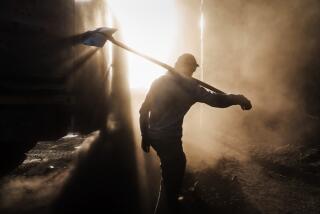Western troops’ finest foe in southern Afghanistan
- Share via
COMBAT POST BARROW, AFGHANISTAN — Thousands of U.S. and other Western troops in the south of Afghanistan do battle daily with a foe far more ubiquitous than Taliban insurgents: dust.
Chalky and powdery, it fouls engines and electronic gear. It seeps through the seams of clothing and sleeping bags. It cakes dry lips, stains sweaty faces and coats the interiors of tents and armored vehicles.
Food and water take on a gritty tang. With the consistency of talc, the dust of southern Afghanistan is billowy when dry, slimy when wet, with a concrete-hard crust when it re-dries. Locals use it to build the durable mud-brick compounds that dot the desert, home to Afghan civilians and combatants alike.
Inert, the dust presents an infinite-seeming horizon, particularly eerie when viewed through night-vision goggles. Whipped by wind into funnel clouds that can reach hundreds of feet in the air, it is the bane of military aviators.
Choking clouds of it are kicked up whenever convoys roll past or helicopters land. At one remote U.S. Marine base, a visitor was cheerfully informed, “You’ll be coughing up mud balls for a week!”
Dust played a well-documented role in ancient warfare, serving as a kind of antique early-warning system. Some generals used guile to make their approaching armies appear larger than they were, creating huge dust clouds with mules dragging bundles of branches.
In a modern-day setting, the vast, bare expanse of Afghan desert provides little cover for insurgents; even a small band of fighters can be readily sighted. But Western convoys, too, are visible for miles, with their signature halo of dust.
In rustic military outposts where indoor and outdoor living blur together, any piece of gear left unattended acquires a film of fine grit within moments. Undisturbed for a day or two, mundane objects like plastic-wrapped crates of drinking water come to resemble relics of a lost civilization.
Despite the primitive living conditions, military outposts are hives of high-tech equipment: surveillance cameras that sweep the surrounding desert, monitors relaying footage from unmanned aerial drones. All need constant cleaning or they will become dust-clogged -- “canned air saves us,” said Marine Pfc. Conor Wood of Ronkonkoma, N.Y.
When a desert dust storm sweeps through, it can take with it almost anything that isn’t tied down, and sometimes things that are. This month, Marines at a forward operating base in Farah province built an open-sided mess hall, but had only a few days to admire their handiwork before a sandstorm blew the roof off.
With dust as a daily companion, personal hygiene is a losing battle. Grit insinuates its way into crevices between teeth -- and among the bristles of toothbrushes used to scrub them. And woe betide any wearer of contact lenses.
There’s no plumbing in the remotest outposts, only solar showers that deliver a chilly deluge few wish to brave. Many Marines go months without a shower, growing more dust-crusted by the day. They launder their own fatigues, one said, “when the pants are standing up, waiting for you to climb into them.”
Springtime is the season of sandstorms, and in the open desert, they approach as a ghostly vision, turning the air yellowish, then greenish, then black.
“At 1500 hours [3 p.m.], it was like the middle of the night,” said Navy medical corpsman Joshua Steinhilber of Webster, N.Y., describing a dirt-blasted tempest that recently swept through. “We figured it had to be either the Apocalypse or a dust storm bearing down,” he said. “So a dust storm -- that was fine.”
--
--
King was recently on assignment in Afghanistan.
More to Read
Sign up for Essential California
The most important California stories and recommendations in your inbox every morning.
You may occasionally receive promotional content from the Los Angeles Times.










